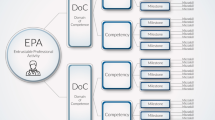Abstract
There are increasing calls to graduate physicians with a strong understanding of health systems science (HSS). Many schools have incorporated didactics on health systems science content such as quality improvement, patient safety, or interprofessional education. Creating a systems-ready physician requires more than teaching content in classroom settings. Using Miller’s pyramid of assessment of clinical performance, we have developed strategies to move our learners from the cognitive-based “knows” level to the behavior-based “does” level of understanding of the HSS competencies. Our medical students begin learning HSS in classroom settings. Next, the students apply this knowledge during their core clerkships. This gives them an opportunity to get feedback increasingly from high-fidelity clinical settings.
We embedded assessment strategies and tools in the clerkship year to facilitate the demonstration, observation, and assessment of HSS competencies in the setting of our core clerkships. We also have students self-assess their competence in our graduation competencies at the end of each year. Student self-assessment from the beginning of the clerkship year to the end showed significant increases in the HSS competencies. Our clerkship student assessment data from our first cohort suggest that faculty had difficulty observing and assessing some of the competencies unique to health systems science. The clerkships have developed multiple projects and assignments to allow students to demonstrate HSS competencies. Faculty and resident training to prompt, observe, and assess these competencies is ongoing to close the assessment gap. In the area of professionalism, student self-assessment and faculty clinical assessment correlate strongly.


Similar content being viewed by others
References
American Medical Association. Accelerating change in medical education. https://www.ama-assn.org/amaone/accelerating-change-medical-education. Accessed April 27, 2019.
Gonzalo, Jed D et al. Health systems science curricula in undergraduate medical education: identifying and defining a potential curricular framework Academic Medicine, 04/2016, Volume 92, Issue 1 Miller GE. The Assessment of Clinical Skills/Competence/Performance. Acad Med 1990. 65(9): 63–67.
Gonzalo JD, Haidet P; Blatt B, Wolpaw DR Exploring challenges in implementing a health systems science curriculum: a qualitative analysis of student perceptions Medical Education, 05/2016, Volume 50, Issue 5.
Gonzalo JD, Caverzagie KJ, Hawkins RE, Lawson L, Wolpaw DR, Chang A Concerns and responses for integrating health systems science into medical education Academic Medicine, 06/2018, Volume 93, Issue 6.
Gonzalo JD; Lucey C, Wolpaw T, Chang A Value-added clinical systems learning roles for medical students that transform education and health: a guide for building partnerships between medical schools and health systems. Academic Medicine, 08/2016, Volume 92, Issue 5.
Gonzalo JD, Dekhtyar M, Hawkins RE, Wolpaw DR. How can medical students add value? Identifying roles, barriers, and strategies to advance the value of undergraduate medical education to patient care and the health system. Acad Med. 2017;92(9):1294–1301(8).
Gonzalo JD, Graaf D, Johannes B, Blatt B, Wolpaw DR. Adding value to the health care system: identifying value-added systems roles for medical students. A J Med Qual. 2017;32(3).
Gonzalo JD, Thompson BM, Haidet P, Mann K, Wolpaw DR A constructive reframing of student roles and systems learning in medical education using a communities of practice lens Academic Medicine, 12/2017, Volume 92, Issue 12.
Miller GE. The assessment of clinical skills/competence/performance. Acad Med. 1990;65(9):S63–7.
Cruess RL, Cruess SR, Steinert Y. Amending Miller’s pyramid to include professional identity formation. Acad Med. 2016;91(2):180–5.
The University of Texas at Austin Dell Medical School Leading Edge Curriculum https://dellmed.utexas.edu/education/academics/undergraduate-medical-education/leading-edge-curriculum. Accessed April 28, 2019.
Reiter HI, Eva KW, Rosenfeld J, Norman GR. Multiple mini-interviews predict clerkship and licensing examination performance. Med Educ. 2007;41(4):378–84.
Davis DA, Mazmanian PE, Fordis M, Van Harrison R, Thorpe KE, Perrier L. Accuracy of physician self-assessment compared with observed measures of competence: a systematic review. JAMA. 2006;296(9):1094–102.
White CB, Gruppen LD, Fantone JC. Self-regulated learning in medical education. Understanding medical education; 2014. p. 271–82.
Gonzalo JD, Ahluwalia A, Hamilton M, Wolf H, Wolpaw DR, Thompson BM Aligning education with health care transformation: identifying a shared mental model of "new" faculty competencies for academic faculty Academic Medicine, 02/2018, Volume 93, Issue 2.
Acknowledgments
The authors would like to acknowledge Dr. Sue Cox, executive vice dean of academics and chair of the Department of Medical Education, and Dr. Christopher Moriates, assistant dean for health care value in the Department of Medical Education, for their important contributions in designing the Dell Medical School Leadership and Health Systems Sciences Curricula.
Author information
Authors and Affiliations
Corresponding author
Ethics declarations
Conflict of Interest
The authors declare that they have no conflict of interest.
Additional information
Publisher’s Note
Springer Nature remains neutral with regard to jurisdictional claims in published maps and institutional affiliations.
Rights and permissions
About this article
Cite this article
Salib, S., Corliss, S.B., Annamalai, V.R. et al. From Knowing to Doing: Integrating Systems-Ready Physician Competencies in the Clerkship Setting. Med.Sci.Educ. 30, 1157–1167 (2020). https://doi.org/10.1007/s40670-020-00984-3
Published:
Issue Date:
DOI: https://doi.org/10.1007/s40670-020-00984-3




